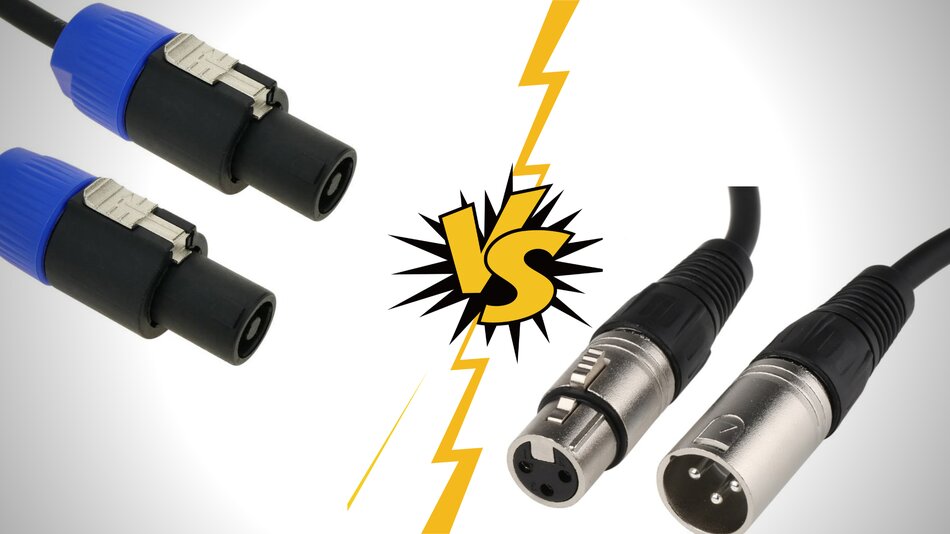
If you are someone involved in professional audio, then you’re probably familiar with Speakon and XLR connectors and knows when to use them. But for those who aren’t familiar with these two connectors, this is the article for you. I will talk about Speakon and XLR, the differences and address some of the common questions most people have about them. Let’s get into it.
Speakon is primarily used for speaker-level signals. Simply put, they are made to transmit audio signals from a power amplifier to a speaker. On the other hand, XLR is primarily used for microphone signals and line-level signals.
Table of Contents
What is a Speakon?
A Speakon is an electrical connector that is used for connecting loudspeakers and stage monitors to power amplifiers. Speakon is the music industry’s standard cable connection for linking power amplifiers to loudspeakers.
Neutrik originally produced Speakon connectors. This company is one of the leading manufacturers of audio connectors. Speakon cables are used to feed signals from power amplifiers to large PA or audio systems.
What is an XLR?
XLR stands for External Line Return. XLR connectors are audio connectors associated mostly with audio devices such as microphones, amplifiers, speakers, and soundboards. And XLR is undoubtedly one of the most popular audio connectors you’ll find in the audio space.
They are used for both live and recording studio applications.
Typical XLR cables are made from 3-pin XLR connectors. Aside from 3-pin XLR connectors, there are XLR connectors that have more than three pins. However, the commonest XLR connector available is the circular 3-pin XLR.
Hence in the world of audio, when the term XLR is made mention, this usually refers to 3-pin XLR connectors. XLR cables are used for transmitting balanced mono mic or line-level signals.
If you want to learn more about XLR connectors and cables, we have extensively discussed it in our article on “XLR vs ¼ Inch.” You should definitely check it out.
Is Speakon The Same As XLR?
Speakon is not the same as XLR. XLRs are not rated to carry the same current loads that Speakon connections normally carry. Speakon connectors are built for high current and amplified signal-level applications. On the other hand, XLRs are designed for microphone and line-level applications.
Speakon is different from XLR. Speakon is conducive for use in high current applications. They are made to carry a high-level signal (or speaker-level signal) like the audio signal from a power amplifier and deliver them to loudspeakers.
This is because they have been designed to accommodate and carry electrical current of high capacity. This high capacity of electrical current is directly proportional to the quality of audio that we hear. This means Speakon cables deliver high-quality audio.
Speakon is designed to carry amplified audio signals, while XLR is meant for non-amplified level signals. These non-amplified level signals are microphone and line-level audio signals. This is why Speakon cables are used for amplifier-to-speaker connections, while XLR is usually used for microphone-to-mixer connections and other line-level connections.
Differences Between Speakon And XLR
Transmit Signals of Different Levels
XLRs are designed to carry both line level and microphone signals, while Speakons carry speaker level signals. Microphone level signal refers to the voltage of the signal produced by a microphone. This signal level is the lowest and weakest among all the audio signals available.
Line level signals are audio signals that are higher than microphone level signals but lower than speaker level signals. Speaker-level signals are line-level signals that have been amplified. XLR cables are meant for microphone and line-level signal transmission, while Speakon cables carry speaker-level signals.
Any powered speaker that is connected using an XLR microphone cable is basically receiving a line-level signal from the XLR cable to its inbuilt power amp. These powered speakers contain internal amplifiers and speaker wiring. Due to this, powered speakers can be considered as line-level devices.
Transmit Different Amounts of Current
Speakon cables are designed purposely to be used in high current audio applications. Speakon connectors accept larger wires. Due to this, they carry more current as compared to XLR cables.
Speakon has a current rating of at least 30 amps and can be used with high voltage audio equipment like pro audio speakers and power amplifiers. This current rating is higher than that of XLR.
XLR cables are designed for low current applications. They have a current carrying capacity of about 15 amps, which is not conducive for high voltage power amps. Due to this, Speakons are better conductors of high-level electrical current than XLRs.
Speakon and XLR connectors visually look different.
XLR connectors have a distinguishable metal plug/pin. XLR connectors have a circular metallic connector with three pins that help transmit balanced microphone and line-level signals. These three pins serve as the positive, negative, and ground.
Unlike XLRs that have a metallic connector casing, Speakon connectors have a distinct blue and black plastic robust casing. It has its connectors inside the plastic casing. Speakon connectors are designed to have their contacts in two concentric rings. It has inner contacts names +1,+2, and outer contacts named -1,-2.
Benefits of Speakon Over XLR
Better Conductor of Current
Due to the design and contact area of Speakon connectors, they can handle high levels of current. Speakon connectors are also designed to accommodate cables with large diameter sizes.
These types of cables are high gauge cables and are capable of carrying large amounts of currents. That is why Speakon cables can drive high voltage audio equipment like loudspeakers.
Most XLR cables are made from relatively thin cables. These cables cannot conduct large amounts of currents like the high gauge cables used in Speakon cables. This makes Speakon cables better conductors of current than XLR.
Speakons are easy to build and fix
Speakon cables are very simple and do not require expert knowledge in order to build or fix one. This makes servicing Speakon cables very easy to do. You can even build a new Speakon cable with just a screwdriver and a plier within a few minutes.
Speakon connectors are built with screw terminals inside the connector housing. Whenever the wires become unseated from the terminals, you can easily fix them back using a screwdriver.
However, when an XLR cable is faulty, it is difficult to repair it on the spot. This is because you will need a soldering kit in order to fix it. If you are not used to soldering, this task might end up being time-consuming.
Durable
Speakon connectors are very durable. Especially original Speakon plugs manufactured by Neutrik. Most Speakon cables are very durable and have flexible construction. This ensures that Speakon stands up to frequent use as well as bending and wrapping during storage and transportation.
Speakon connectors are also designed to have a strain-relief collar which prevents excessive flexing of wiring near the connectors.
Benefits of XLR Over Speakon
Transmit Balanced Audio
Balanced audio signals and cables are usually preferred to unbalanced ones because balanced cables can filter out interference. This is because these cables have positive and negative wires which carry audio signals in opposite polarities.
XLR cables are designed primarily to transmit balanced mono signals. This means they have dual polarity when it comes to signal transmission. Due to this, XLR cables are able to carry mono audio signals without any sound interference such as noise and hum.
On the other hand, Speakon cables are unbalanced cables. They have only one polarity when it comes to signal transmission. This makes them susceptible to interference when used for long applications.
Cheaper
XLR cables are made from relatively thin cables. They are usually referred to as microphone cables. These microphone cables are quite cheap as compared to the thick wires used in making Speakon cables.
Cables used in making Speakon cables are very thick, making them conducive for carrying the high voltage required for driving loudspeakers. Due to this, these Speakon cables are relatively expensive as compared to XLR cables in general.
Is Speakon Better Than XLR?
Years ago, both speakers and microphones used XLR connectors. However, that is not the case in recent times. XLR connectors have evolved to become the audio industry’s standard for connecting microphones and line-level audio equipment.
On the other hand, Speakon is the industry standard for speaker connections. This means Speakon and XLR do not serve the same purpose.
Speakon cables and XLR cables are used for different applications. Speakon is used only for transmitting speaker-level signals, while XLR cables are used for microphone and line-level signals. Hence it is technically impossible to judge which one is better between the two since they don’t perform the same task.
One of the main features that Speakon connectors have is that they come with a useful twist and lock design that ensures no connection fallout during live programs.
This is one of the main reasons why Speakons easily replaced 1/4″ cables as the standard connectors for speakers. You can read more on this in our related article, “Speakons vs. ¼.”
Though this twist and lock feature in Speakons is very useful, XLR connectors also come with a simple but extremely useful locking design feature.
This design feature ensures that XLR cables cannot be pulled out accidentally during gigs as well. Therefore, it can be quite difficult to pinpoint which is better between XLRs and Speakon.
The only high point Speakons have over XLRs is that Speakons are capable of carrying high-level signals. XLRs, on the other hand, are meant primarily for carrying low-level signals. However, if you do not plan to use your XLR microphone cable to carry speaker-level signals, this problem shouldn’t even pop up.
Can You Connect Speakon To XLR?
You can connect Speakon to XLR. Speakon can be connected to XLR connectors and used for speaker connections without encountering any problems. However, the cable used for such connections should be speaker cables, which are usually thicker than microphone cables.
XLR cables are usually thin and are built for mic and line-level signals. This means they won’t be able to handle the high level of wattage required for driving loudspeakers.
So when you want to make a speaker cable with XLR connectors, do not use the standard thin XLR microphone cables. You should use thick wires. This is because these thin cables might not be able to handle the power requirements of your amplifier and loudspeaker.
There are even pre-made XLR that come as speaker cables. This type of cable consists of a Speakon plug connector at one end, joined to an XLR connector using a speaker wire. This type of cable gives you interface functionality between Speakon and XLR connection types.
This Speakon to XLR cable on Amazon is exactly what you need. It’s a 25ft long cable, which is long enough to fit most needs. One end of this cable is a Speakon connector, and the other end is a female XLR connector with a locking mechanism. And the wire thickness is 16 gauge, making it ideal for short cable runs for your power amp or speakers — anything less than 50ft.
Conclusion
XLRs are typically used for transmitting low-level signals. They are used for transmitting microphone-level signals and line-level signals in general. Speakon is designed for high-power connections. They are used to carry post-amplification signals.
Therefore, Speakons are intended for high power connections, while XLRs are meant for low power connections.

Hello, I’m Elijah. A writer on Geek Musician, based in Ghana-West Africa. I am a writer with a passion for research and reading. I usually spend my free time playing chess or watching movies. For more info, check out my about me page. Or read more of my articles here.
